How to memorize a diode's polarity, such as anode and cathode in symbol?
-
5It's like 2-bit information. Really not hard to remember... – Eugene Sh. Jun 06 '16 at 18:58
-
5A comes before C – Jun 06 '16 at 19:00
-
This was a self-answered question. the answer was the prior. however, there occurs a lots of misconceptions in the students. Sometimes peoples learn "this is the plus-end" or "this-one is minus", without knowing, that "plus" may be a "positive input" or "positive output". – Always Confused Jun 06 '16 at 19:17
-
The arrow points in the direction of POSITIVE current flow. (Thank you, Ben Franklin!) Of course, in, say, a vacuum tube, electrons flow from cathode to anode, so positive current flows towards the cathode. – Hot Licks Jun 06 '16 at 21:52
-
3And, of course, an NPN transistor is *not pointing in*, while a PNP transistor is *pointing in proudly*. – Hot Licks Jun 06 '16 at 21:54
-
2Is the question as simple as I think it is? – Bradman175 Jun 06 '16 at 23:47
-
1When I was student this was a problem then I think this isn't a question as stupid as it sounds. For me was easy because my name start with A and my surname with P, then A(node) is the P part of P-N junction (I never found written N-P junction), thus the order is P-N and the arrow indicate this order. Anode (P) ->|- Cathode (N). Your nick is Always Confused. I said **A**lways **C**onfused. There's more to say? ;-.) – Antonio Jun 29 '16 at 07:52
-
1@EugeneSh. 2 bit information, hence easy to remember? Not for me at least. I feel trouble to memorize where to use **"have"** or **"has"** , but can very easily remember the working of a Nipkow Disk. Maybe a turing-test (like Captcha)? – Always Confused Aug 09 '16 at 09:55
-
Draw it on a post it note and stick it to your monitor – Voltage Spike Jul 06 '18 at 21:50
7 Answers
Two mnemonic technique I'll mention. Both technique I've learnt from someone else, many-years ago.
- We can easily remember, anode is abbreviated as A, and Cathode as K. That is standard, and easy to remember.
Now , Write a K
Now, just fill in the blanks to make it a diode.
Now , the side of diode, where K was drawn, is Cathode (K).
By default, the opposite side is anode (A).
Now, if once we learn to recognize the K, if the diode orientate to a different direction in the diagram, we could easily identify the anode and cathode.
-----------------------------------------------------------------
- The triangle inside the diode, makes an arrow sign. That tells the direction of allowed-direction of current.
From the second-method , we-can easily remember, the direction of current.
And ow. A selected portion of Circuit portion(portion of interest)(here diode)'s Cathode is the electrode that Vomits out-out positive-charge;
and the circuit's portion-of-interest(here diode)'s Anode is the electrode that Sucks-in the positive charge.
above-table: Anode-Cathode Vs Plus-Minus Disambiguation
That is applicable not only for diodes. It is applicable for any-components like Electrochemical (Battery)-Cell, , Electrolytic-cell, Cathode-ray-Tube(CRT), etc.
Circuit's portion-of-interest(here diode)'s Anode is to be attached with circuit-counterpart(here battery)'s Cathode.
And Circuit's portion-of-interest(here diode)'s Cathode to be attached with circuit's Counterpart(here battery)'s Anode.
Within the circuit's portion of interest (Here it is diode), Current flows in its Anode to Cathode direction.
In that selected portion's counterpart, or outer-portion of the path, current flows from Anode(of the selected part, here diode) to Cathode ( of the selected part, here diode).
- 1,591
- 6
- 25
- 49
Just dreamed up while reading this question and answers:
If you don't remember which is which, your
A+(anode, + voltage) will become (flow towards*) aC-(cathode, - voltage).
We'll see if that or something like it actually helps me (and/or others) remember. :)
* note: flow referring to conventional current, rather than electron flow.
(Also, I realize this is only about memorizing which name is which (which is what I was trying to remember when I found this question); I yield to other answers for getting the names and symbol mapped.)
- 151
- 1
- 3
-
-
And for a battery or perhaps various other things, that would be correct. But the original question was specifically about "a diode's polarity", and in that particular case, the anode is labeled as + and the cathode as -... It's all very confusing. Thankfully, the answer by Always Confused seems to... allow one to become clear on it, if only briefly. – lindes Dec 31 '20 at 13:30
In the schematic symbol, the straight line across the wire is the cathode, and on the physical part, the cathode is usually marked by a line.
The arrow in the schematic symbol for diodes and transistors points in the direction of Conventional (positive) current flow.
simulate this circuit – Schematic created using CircuitLab
- 57,014
- 1
- 48
- 127
-
1This answers the question of which is which, but not the question of how to remember it, which is how I'm interpreting the original question. Thoughts on memory aids? – lindes Aug 03 '18 at 17:29
Think of cats (felines), a lot of people think that cats are bad. Bad is synonymous with negative and that's why the CAThode side is also the negative side. That's the way I was taught by my professor.
- 31
- 1
-
[But what about the cats?](https://media.istockphoto.com/photos/cute-kitten-portrait-british-shorthair-cat-picture-id916159418?k=6&m=916159418&s=612x612&w=0&h=3wU_DQ35jXhHLPeHHfsITav-hSSxLLB49zUFS0LoLZs=) – D.Deriso Dec 22 '18 at 09:00
-
I don't think your professor anticipated the Internet would become what John Oliver calls, "The World Cat Database". Clearly a lot of people like cats too haha – ABCD.ca Sep 24 '20 at 23:10
What I always remember is Anode - Arrow - Acceptor. The triple "A" of diodes.
The anode is the name, The arrow is the triangular bit of the symbol and the fact that it is made from acceptors means it is P-type.
All the converse parts are true then.
The bar is the cathode, which is the made from donors which is N-type.
You may not care about the acceptor and donors aspect, but that is important for me.
- 29,982
- 10
- 63
- 110
My trick to remember Anodes and Cathodes in most electrical systems is to think of a CRT, which, as you all know, stands for Cathode Ray Tube. Most of you are also familiar with how it works; namely, it shoots (negative) electrons at a screen. Thus, Cathodes are usually the negative pole of an electrical system and thus, diodes point towards them.
It's a convoluted trick but it just clicks with me.
- 121
- 1
Think of P as positive. Then just look for the P shape in symbol. This makes it easy to remember.
(source: graffitialphabet.org)

- 1,245
- 3
- 15
- 20
- 159
- 5
-
2How does a big orange "P" help you remember which is the anode and which is the cathode? – Transistor Jun 07 '16 at 08:35
-
@transistor read the answer. P = positive. And P is the shape of the anode in diode's symbol – xyz Jun 07 '16 at 08:39
-
Thanks This will help me to remember the placement of **P-type Semiconductor-Crystal** , and by-default N-type crystal is the other end. However the N-type crystal terminus forms an **"N" like shape.** – Always Confused Jun 12 '16 at 16:59
